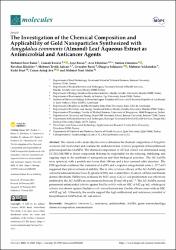The Investigation of the Chemical Composition and Applicability of Gold Nanoparticles Synthesized with Amygdalus communis (Almond) Leaf Aqueous Extract as Antimicrobial and Anticancer Agents
Citation
Baran MF, Keskin C, Baran A, Eftekhari A, Omarova S, Khalilov R, Adican MT, Rosić G, Selakovic D, Yıldıztekin M, Kurt K, Aytuğ Ava C, Atalar MN. The Investigation of the Chemical Composition and Applicability of Gold Nanoparticles Synthesized with Amygdalus communis (Almond) Leaf Aqueous Extract as Antimicrobial and Anticancer Agents. Molecules. 2023 Mar 7;28(6):2428. doi: 10.3390/molecules28062428. PMID: 36985400.Abstract
The current work's main objective was to determine the chemical composition of Amygdalus communis (AC) leaf extract and examine the antibacterial and cytotoxic properties of biosynthesized gold nanoparticles (AuNPs). The chemical composition of AC leaf extract was determined using LC-ESI/MS/MS to detect compounds that may be responsible for the reducing, stabilizing, and capping steps in the synthesis of nanoparticles and their biological activities. The AC-AuNPs were spherical, with a particle size lower than 100 nm and a face-centered cubic structure. The EDX spectrum confirmed the formation of AuNPs and a negative zeta potential value (-27.7 mV) suggested their physicochemical stability. The in vitro cytotoxic efficacy of the AC-AuNPs against colorectal adenocarcinoma (Caco-2), glioma (U118), and ovarian (Skov-3) cancer cell lines and human dermal fibroblasts (HDFs) was evaluated by MTT assay. CaCo-2 cell proliferation was effectively inhibited by the AC-AuNPs at concentrations between 25 and 100 g mL-1. The AC-AuNPs exerted preeminent antimicrobial activity against Bacillus subtilis with an MIC of 0.02 μg/mL, whilst good activity was shown against Staphylococcus aureus bacteria and Candida albicans yeast with an MIC of 0.12 μg/mL. Ultimately, the results support the high antibacterial and anticancer potential of biosynthesized AuNPs from AC leaf extract.


















